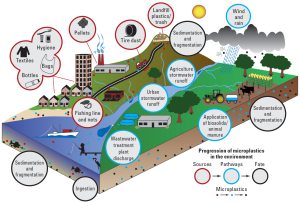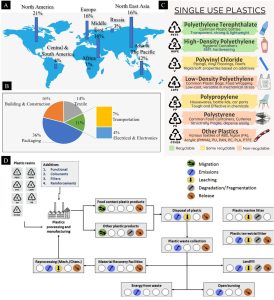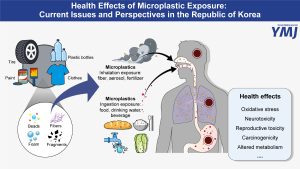19 The Global Distribution & Impacts of Microplastics
jrluman1
Ever since plastic waste has become spread worldwide because of ever-increasing industrialization, microplastics have followed suit. Microplastics have now been detected in virtually every facet of the planet, from urban environments to the most remote ecosystems. Their concentrations have continually been increasing in the soil, atmosphere, and water. The widespread distribution of microplastics can largely be attributed to their lightweight nature, allowing them to become airborne and travel long distances by wind or being easily swept away by water currents. As discussed previously, human-production of plastic has exponentially increased in the last century which certainly doesn’t help with the ever-increasing concentrations of microplastics in various environments (Yang et al., 2025). This subsection of the chapter will focus specifically on the worldwide impacts of microplastics in the way they are distributed throughout the worldwide environment, both indoors and outdoors, with a primary focus on airborne microplastics along with the mitigation strategies that have arisen as more awareness of microplastics has been raised. (JL)
Worldwide Distribution and Environmental Fate
As introduced earlier in this chapter, microplastics can be categorized as either primary or secondary, depending on how they are produced. However, beyond their type, it is also important to consider the specific sources through which these particles enter the environment. These sources are broadly divided into point and nonpoint sources. Point sources release microplastics from identifiable, localized origins, whereas nonpoint sources discharge microplastics diffusely across larger areas, making them harder to trace and manage. (JL)
Common point sources include industrial and municipal wastewater outfalls, stormwater drains, and emissions from industrial smokestacks. In cases where outfalls are untreated, microplastics are directly discharged into nearby rivers and streams, where they are subsequently transported to lakes, estuaries, and oceans. In countries with developed wastewater treatment infrastructure, approximately 72% of microplastics are removed through primary treatment, and up to 94% can be eliminated with tertiary treatment (ITRC, 2021). However, this level of removal is not universal. Developing countries, which may lack advanced treatment facilities, often experience higher microplastic discharge into surface waters used by local populations and ecosystems. (JL)
Even when microplastics are removed during treatment, they do not disappear. These particles are often concentrated in biosolids, which are either incinerated, landfilled, or applied to soils as amendments intended to alter soil characteristics. During drying or land application, wind can easily disperse microplastics from biosolids into the surrounding environment. Other notable point sources include discarded or lost material from commercial shipping, passenger vessels, and aquaculture facilities (ITRC, 2021). (JL)
In contrast, nonpoint sources are more difficult to identify and manage due to their diffuse nature. These include stormwater runoff, atmospheric deposition, and the application of biosolids on agricultural land. Additional contributors include tire wear particles, erosion of synthetic materials, and residues from urban and household waste. Airborne microplastics, which are an emerging area of concern, frequently originate from synthetic textiles, abrasion of vehicle tires, and the resuspension of city dust. Because nonpoint sources can stem from nearly any landscape or weather-driven process, their mitigation poses a significant global challenge (ITRC, 2021). (JL)
Microplastics have been detected in water sources across the globe, originating from a range of both point and nonpoint sources. Nearly all surface water bodies are contaminated with microplastics, not only through direct discharges but also due to atmospheric deposition, which allows particles to reach remote and otherwise unaffected locations. Although microplastics are far more prevalent in surface waters, they have also been found in groundwater—albeit in more limited quantities. Research on microplastics in groundwater is still emerging, but studies in countries such as the United States, Germany, and South Africa confirm their presence in subsurface water systems. A study conducted in northern China by Jingyun Shi and colleagues revealed that microplastic concentrations in groundwater are highest near sewage treatment plants, landfills, and agricultural areas, especially those involved in vegetable production. This same study identified a link between microplastics and antibiotics, showing that microplastics can bind to antibiotic molecules through hydrogen bonding, hydrophobic interactions, van der Waals forces, and electrostatic interactions. This binding reduces the degradation of antibiotics in both soil and water environments. According to separate studies by Samuel Panno, Viviana Re, and their teams, microplastics can enter groundwater systems through fractures, losing streams, soil crevices, conduits, and karstic features such as branch-work caves. Smaller microplastic particles are particularly prone to migrate deeper into the subsurface (ITRC, 2021). (JL)

Determining the exact quantities of microplastic contamination across different global regions remains challenging. However, studies on marine environments around the world provide insight into the scale of contamination faced by each area. Since plastics became widely used across societies, microplastics have been detected in every ocean—including remote regions such as the Arctic, Antarctic, deep sea, and mid-ocean islands. For example, a study of California’s coastal waters estimated that nearly two billion microplastic fragments were discharged by two rivers in less than three days. In the San Francisco Bay, microplastic concentrations ranged from 15,000 to 20,000 particles per square kilometer. Similarly, at an intertidal site near a shipbreaking yard in India, microplastic concentrations reached 81 ppm (mg/L). Research conducted in Arctic waters near Svalbard, Norway, reported particle concentrations ranging from 0 to 1.31 particles per cubic meter in southern waters and 0 to 11.5 particles per cubic meter southwest of the site (Auta et al., 2017). As the presence of microplastics continues to grow, numerous studies are underway to better quantify global concentrations and distributions. Figure 2.1 illustrates a global map of microplastic distribution in kilograms per square kilometer, showing the highest concentration within the North Pacific Gyre, located off the coast of California. Other regions of the world’s oceans display similar levels of contamination, suggesting widespread and persistent microplastic pollution across marine environments. (JL)
Later sections of this chapter will explore in greater detail the impacts of microplastics on the world’s oceans and aquatic ecosystems, as well as their occurrence in drinking water, soil, and food sources. For now, however, the following subsection will specifically examine the presence of microplastics in both atmospheric and indoor air environments, along with their associated effects. (JL)
Microplastics in the Air
As noted earlier in this chapter, the small size of microplastics makes them lightweight enough to become easily airborne. Originally, chemists did not expect plastics to be likely candidates for seeding cloud droplets due to their typically hydrophobic properties and common applications in textiles and packaging. However, recent research has shown that microplastics can in fact serve as cloud condensation nuclei—sometimes quite effectively. These airborne particles are capable of traveling thousands of miles from their source, as demonstrated by a study in the Pyrenees Mountains, which confirmed that microplastics deposited via rain and snowfall had originated far from the area of study (Jones, 2023). (JL)
In the United States, a significant dataset on “plastic rain” was compiled by Janice Brahney of Utah State University and her coauthors. While originally studying airborne phosphorus, Brahney unexpectedly discovered high concentrations of microplastics in ground-based air filters, including colorful fragments that had no relation to her intended research. This discovery led to a broader investigation across federally protected areas, confirming widespread plastic contamination from atmospheric sources. (JL)
To trace the origin of this airborne plastic, Brahney’s dataset wasanalyzed by Cornell University professor Natalie Mahowald. Using atmospheric modeling, Mahowald mapped Brahney’s findings against known sources of airborne microplastics, including roads, agricultural activity, and ocean spray. Her model showed that in the western United States, 84% of airborne microplastics came from roads, 11% from the oceans, and 5% from agricultural dust. The study also confirmed that a portion of the plastic had traveled thousands of miles from its source before deposition. (JL)

Though individual microplastic particles may only remain suspended in the atmosphere for a few weeks, their continuous reintroduction into the air means they are constantly present—especially in urban areas. It is virtually certain that people living in cities are inhaling microscopic plastic fragments on a regular basis. Despite valuable datasets like Brahney’s, accurately quantifying global atmospheric microplastic concentrations remains difficult. Most studies rely on collecting particles with air filters, examining them under microscopes for shape and color, and confirming composition using spectroscopic methods. As microplastics shrink to the nano-scale, they become harder to detect, making airborne nanoplastics even less understood than their micro-scale counterparts. (JL)
Concentration levels of airborne microplastics vary widely across the globe, from as low as 0.01 particles per cubic meter over the western Pacific Ocean to several thousand particles per cubic meter in highly urbanized cities like London and Beijing (Jones, 2023). As with other environmental media, cities tend to show the highest concentrations overall. Currently, according to Mahowald, airborne microplastics make up only a small fraction of total atmospheric aerosols, meaning they are likely to have a limited impact on climate processes at this time. However, because microplastics are less dense than most other aerosols, they can travel farther and may become dominant airborne pollutants in cleaner regions. With continued growth in global plastic production and accumulation, this influence could increase significantly in the future (Jones, 2023). (JL)
Airborne microplastics are most commonly composed of synthetic polymers such as polyethylene (PE), polypropylene (PP), polystyrene (PS), polyethylene terephthalate (PET), and polyvinyl chloride (PVC). Human exposure to these particles increases significantly indoors, where limited air circulation and lack of dispersion mechanisms allow microplastics to accumulate over time. Unlike outdoor environments where wind and precipitation can carry microplastics away, indoor microplastics tend to remain suspended in the air or settle into dust, especially in enclosed spaces with frequent human activity. (JL)
A study by Peng et al., cited in Dewika (2023), found high concentrations of polyamide in indoor dust ranging from 8.15 to 321 mg/kg, demonstrating the significant presence of microplastics within indoor environments. Another study conducted across offices, schools, and apartments in Surabaya, Indonesia, showed that weekday microplastic concentrations were notably higher than on weekends, suggesting a strong correlation between human presence and plastic particle generation. Daily use of plastic-based products—including packaging, synthetic textiles, and personal items—inevitably contributes to microplastic accumulation indoors. (JL)
Further research by Peng et al. compared microplastic concentrations across various environments in China, including indoor dust, sludge, marine and freshwater sediments, and fishery sediment. The findings revealed that nylon microplastics in indoor dust ranged from 0.43 to 92.9 mg/kg, the highest levels observed among all tested media (Dewika, 2023). These results reinforce the idea that indoor spaces act as hotspots for microplastic pollution. (JL)
Multiple studies also indicate that the dominant form of indoor microplastics is fibrous, primarily originating from items like textiles, carpets, upholstery, and clothing. Activities such as laundering and general fabric wear release fibers into the air, especially those made from natural-synthetic blends or petrochemical-based materials. These fibrous microplastics not only contribute to indoor dust but also present a significant inhalation risk for occupants, particularly in poorly ventilated or densely occupied spaces. (JL)
Effects and Mitigation Strategies

As plastic production has skyrocketed over the past century, microplastics have become a nearly ubiquitous pollutant in human environments. As illustrated in Figure 2.X, the regions most responsible for global plastic production—North America, Europe, and Northeast Asia—are also home to some of the most heavily exposed populations. These regions not only contribute significantly to plastic waste but also face elevated risks from airborne, waterborne, and soil-borne microplastics. Still, as noted in the previous section, microplastics are not confined to their points of origin. Their small size and low density allow them to travel great distances, making exposure a global issue, even in populations that contribute minimally to plastic pollution. The figure also highlights the life cycle of plastic and the various environmental pathways through which it migrates. (JL)
Given their persistent and widespread presence, it is increasingly critical for researchers to investigate the health effects of microplastics on human populations and identify strategies for mitigation. Unfortunately, current research into their direct impact on human health remains limited, with most studies to date focused on standardizing detection and tracking methods rather than evaluating long-term biological effects. However, cellular and animal studies have demonstrated a range of potential harms, suggesting that microplastics may negatively affect multiple bodily systems (Lee et al., 2023). (JL)

For the digestive system, ingested microplastics can cause physical abrasion of gastrointestinal tissues, alterations in gut microbiota, and chemical toxicity from associated pollutants. In the respiratory system, inhaled microplastics have been linked to oxidative stress in the lungs and airways, contributing to inflammation and other adverse respiratory symptoms. One study even found that nano-sized microplastics caused mitochondrial damage in human lung cells, raising serious concerns about chronic inhalation (Lee et al., 2023). The endocrine system, which governs hormonal balance, is also vulnerable. Microplastics can interfere with hormone regulation, potentially contributing to metabolic, developmental, reproductive, and immune disorders. (JL)
Further evidence from studies on mice fed polystyrene micro- and nanoparticles showed that microplastics can be neurotoxic, crossing the blood–brain barrier and accumulating in the central nervous system. These accumulations triggered microglial activation (a change in brain immune cell behavior) and resulted in neuron damage. The affected mice also showed signs of cognitive impairment, further highlighting the potential neurological consequences of exposure (Lee et al., 2023). (JL)
While more research is needed to fully understand the long-term impacts of microplastics on humans, the current evidence paints a troubling picture. Without major intervention, both exposure and health risks are likely to increase alongside rising global plastic production and environmental accumulation. (JL)
To address the growing concern of microplastic pollution, several countries have begun to implement national-level policies and initiatives focused on the management and reduction of micro- and nanoplastics. In South Korea, for example, the government has introduced plastic waste-management plans designed to improve microplastic regulation. These initiatives, spearheaded by the Korean Ministry of Environment, began as early as 2018 and aim to promote better handling and mitigation of microplastics through more effective waste management strategies (Lee et al., 2023). (JL)
The international community has also taken initial steps toward mitigation. In 2018, both the United States and France enacted regulations banning the intentional use of primary microplastics in cosmetic and cleaning products. The European Union has since expanded its list of banned products, targeting a wider range of consumer goods containing microplastics (Lee et al., 2023). Globally, strategies to reduce microplastic pollution fall into two main categories: direct regulatory action and indirect prevention efforts. Direct regulation typically includes plastic bans targeting specific emission sources, while indirect regulation focuses on restricting single-use disposable plastics such as plastic bags, straws, and water bottles, and encouraging the use of reusable or biodegradable alternatives (ITRC, 2021). (JL)
Beyond formal regulation, numerous non-regulatory approaches are being pursued to combat microplastic contamination. These include consumer education campaigns aimed at promoting more sustainable habits, as well as the development of environmentally friendly materials that are biodegradable, recyclable, or reusable. Expanding reuse, recycling, and waste disposal infrastructure, particularly in low- and middle-income countries, is also essential. Additionally, investment into advanced plastic disposal technologies—such as chemical recycling or safe thermal destruction—is critical to minimizing the long-term environmental burden (ITRC, 2021). (JL)
The following sections of this chapter will provide a more focused examination of microplastic distribution and impacts within the ocean and drinking water systems, two areas where the environmental and health risks are especially acute. (JL)
*Note about AI Usage in this section: All paragraphs were hand-written at first and then plugged into AI to correct grammar errors and provide a better structure for the flow of information. AI was also used as a citation machine to cite sources in APA format. AI was only used as a correction tool, not a writer. (JL)
